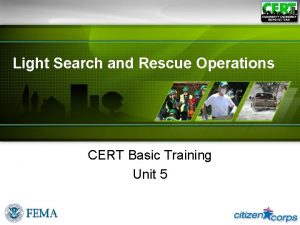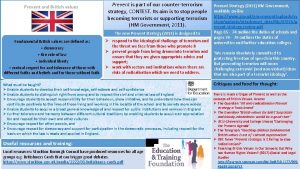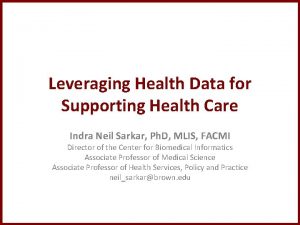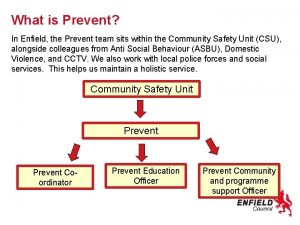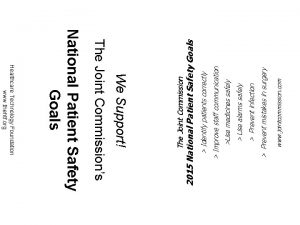Leveraging the Health Care System to Prevent and














- Slides: 14

Leveraging the Health Care System to Prevent and Mitigate ACEs Families USA Health Action Conference 2020 Shadi Houshyar, Ph. D Pronouns: she, hers Senior Associate Center for the Study of Social Po shadi. houshyar@cssp. org

Leveraging the Health Care System to Prevent nd Mitigate ACEs: The Opportunity • Health care is well positioned to address ACEs given it is a nearly universal system • Health care is becoming more attuned to health related social needs

Increase Access to Comprehensive Affordable Health Care for Children, Parents, and Families by Strengthening and Protecting Medicaid & CHIP • States that have not, should take up Medicaid expansion • Extend the continuous eligibility period to five years for children under 6 • Medicaid should be extended from 60 days to a full year postpartum for mothers

Invest in and Scale Home Visiting Programs • In 2014, 48% of families receiving home visiting through the Maternal, Infant, and Early Childhood Home Visiting (MIECHV) Program were living in extreme poverty • Nationwide, 18. 3 million families have a child < 6 or a child on the way who could benefit from home visiting • Evidence-based models reach about 3% • Scaling home visiting will require expansion of federal funding

Promote Strong Collaboration Across Agencies Serving Children and Families • Organize state agencies overseeing Medicaid, maternal and child health, early intervention and early care and education under a common governance structure and leadership • Incorporate relevant agencies into one cabinet department or appoint a Children’s Cabinet or Governor’s Initiative focused on children’s needs • Use data-sharing agreement between Medicaid and agencies including early intervention, child welfare

Expand Financial Support for Utilizing Community Health Workers(CHWs) to Coordinate Care in Pediatric Health and Other Settings • Many CHW programs report a financial return on investment ranging from $1. 50 to $5 for every $1 • Example: Healthy Start Program Madrina uses CHWs to deliver home visiting services and has successfully linked pregnant Latinas to perinatal health care, health education, and support services • Pediatric interventions including Healthy. Steps and DULCE draw on this model to employ a Healthy. Steps specialist or related role in the health care setting to support families

Allow Pediatric Health Providers to Bill for Maternal Depression Screening and Cover Treatment Under Child’s Medicaid Benefit • 5 to 25% of all pregnant, postpartum, and parenting women experience some type of depression • Low-income women experience depressive symptoms at higher rates—between 40 to 60% • Maternal depression prevalence similar across racial and ethnic groups, but black women and Latinas are less likely to receive care • 32 states allow maternal depression screening to be billed under the child’s Medicaid; 19 states do not

Partner with Families at All Levels, Including Policy Development, Program Design, and Implementation • Effective inclusion of voices and priorities of communities of color and other marginalized groups is a matter of equity • Family-centered care and shared decision making also contribute to better health outcomes, improvements in quality and patient safety • Strategies for creating space and lifting the voices of families underrepresented groups

Institute Staff Trainings on Implicit Bias • In health care, implicit bias affects care in a number of ways with harmful consequences for underrepresented patients • For instance, communities of color and other underserved groups are: • Less likely to be prescribed pain medication • More likely to be viewed as medically noncompliant • More likely to be viewed as medication-seeking or having some other motive to seek medication other than receiving needed care • Implicit bias associated with disparities in pain management in pediatric care

Use Institutional Analysis to Identify and Mitigate the Health Harms of Institutional Racism • Institutional Analysis (IA) is often used in child welfare, juvenile justice and other public intervention agencies to confront structural contributors to poor outcomes for children and families • Standardized institutional methods like administration requirements, job descriptions, employee training • Pinpoints inherent organizational policies and practices – underlying structural barriers contributing to inequities • IA could be used to surface and mitigate structural barriers in health care

and Promote Population Health by Better Connecting Integrating Health Care and Social Supports • Social, economic, and environmental factors influence child health • Several models use these strategies in pediatric settings • These models screen for risk factors, concrete supports (e. g. , nutrition assistance, housing needs, utility assistance), child development and parent functioning (e. g. , maternal depression, interpersonal violence), connecting families to services, supports and opportunities

Target Interventions to Young Children Ages Birth to 3 and Their Caregivers • Early childhood is a time of rapid brain development, physical growth, and learning, and sets the foundation for later health, academic success, and social-emotional and behavioral development • Interventions involving parents during the first few years of a child’s life can dramatically improve parental sensitivity, discipline strategies, and encourage supportive, warm parenting • Need for multigenerational approaches that combine caregiver and child health care

Expand Definition and Screening for ACEs

Thank You Shadi Houshyar, Ph. D Pronouns: she, hers Senior Associate Center for the Study of Social Policy shadi. houshyar@cssp. org 202. 371. 1565
 Health and social care component 3
Health and social care component 3 Unit 2 equality diversity and rights
Unit 2 equality diversity and rights Levels of care primary secondary tertiary quaternary
Levels of care primary secondary tertiary quaternary Analyzing and leveraging decoupled l1 caches in gpus
Analyzing and leveraging decoupled l1 caches in gpus Search by image
Search by image Performance ambiguity lowers the cost of control.
Performance ambiguity lowers the cost of control. Line extension vs brand extension
Line extension vs brand extension Leveraging social media for talent acquisition
Leveraging social media for talent acquisition Secondary sources of brand knowledge
Secondary sources of brand knowledge Secondary brand elements
Secondary brand elements Secondary brand knolledge
Secondary brand knolledge Coso three lines of defense
Coso three lines of defense Three lines of defense adalah
Three lines of defense adalah Louisiana leveraging educational assistance partnership
Louisiana leveraging educational assistance partnership Leveraging threat intelligence
Leveraging threat intelligence




